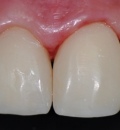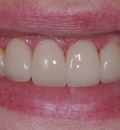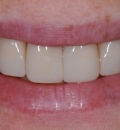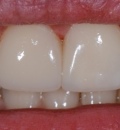Cosmetic dentistry
(1).png)
What is the secret to an attractive smile?
The attractiveness of a smile depends on tooth size, form and color, correct placement, relationship with other teeth and gums (no more than 2 mm should be visible in a smile), symmetry, also lip form and position.
The goal of modern dentistry is to give the patients a beautiful smile.
Cosmetic dentistry
It is a method to restore damaged teeth using modern composite materials according to tooth and dental arch aesthetic parameters. Without preparing and damaging dental tissues, teeth are precisely restored to remain vital and look proportional, natural, shine and function properly.
Cosmetic dentistry requires exceptional skill and accuracy. Dental tissues have to be layered and restored exceptionally precisely.
(1).jpg)
Cosmetic treatment is recommended if the teeth were damaged by decay, are discolored, worn, chipped, if old restorations are unattractive, the teeth are not regular in the dental arch and the defects are not major, if the patient wants to alter tooth form, size and color or fill spaces between teeth.
Materials used for cosmetic dentistry closely mimic natural tooth tissues. They have especially good physical and mechanical properties: low shrinkage, low thermal conductivity, high resistance to chewing forces.
Teeth restored using these materials are strong, transparent, glossy and look natural.
Cosmetic restoration is painless and causes no discomfort, and the results often surpass expectations.
Cosmetic restorations:
- reinforce the tooth;
- look attractive and natural;
- are especially suitable to children and young adults in case of chipped teeth;
- is a quick solution (only one or two visits required);
- require no laboratory procedures;
- less tooth tissue is lost compared to prosthetics;
- a chipped part can be easily restored in one visit;
- can act as an alternative to orthodontic (braces, etc.) or prosthetic treatment.
.jpg)
Direct and indirect restorations
Single teeth can be restored both directly and indirectly. The choice is made considering the size of hard tissue defect, the condition of adjacent teeth and the cost.
Indirect restorations are tooth crown restorations made in the laboratory based on an impression of the prepared tooth. They are later on fixed to the tooth using special materials.
Advantages of the indirect method:
- the restoration is strong and durable;
- lower occurrence of secondary dental decay;
- stability of form;
- occlusal and proximal surfaces are restored accurately.
Disadvantages of the indirect method:
- more tooth hard tissue is lost;
- several visits are needed, because the restoration is made in the laboratory;
- high cost;
- defects hard to repair.
Advantages of the direct method:
- only damaged tooth tissues are removed;
- restoration is carried out in one, sometimes two visits;
- low cost;
- defects easy to repair.
Disadvantages of the direct method:
- tight proximal surfaces hard to restore;
- higher occurrence of secondary dental decay;
- over time micro-gaps form between tooth and restorative material due to setting shrinkage of the material.
(1).jpg)
Composite veneers Componeer – direct nanohybrid composite veneers covering the front teeth. The procedure is carried out over a single visit. The patient has a beautiful white smile.
Advantages:
- commercially fabricated;
- lower price compared to custom laboratory-made porcelain veneers;
- high quality restoration and excellent aesthetic results;
- high surface gloss and marginal fit;
Componeer veneers are available in various sizes and colors; easily repaired and modified using composites.
Neodenta‘s cosmetic dentistry specialists are finalists in the Prisma international professional competition.






















